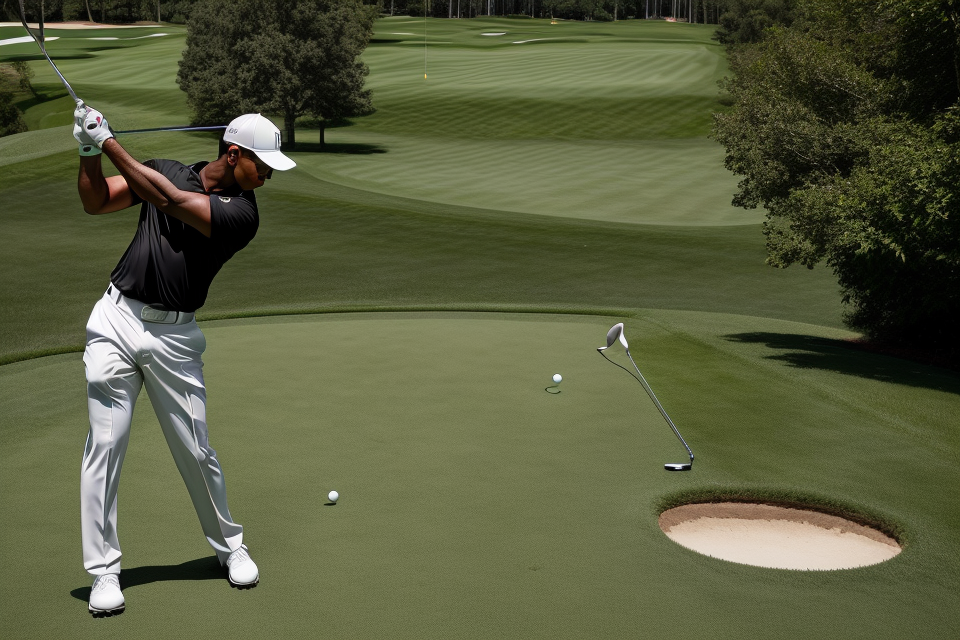Tiger Woods is a professional golfer known for his powerful and accurate swing. His swing has been analyzed and studied by golf experts and enthusiasts for years, and has been credited with revolutionizing the sport. In this article, we will take a comprehensive look at Tiger Woods’ swing, examining the mechanics and techniques that make it so effective. From his grip to his stance, we will break down each aspect of his swing and discuss how it contributes to his success on the course. Whether you’re a seasoned golfer or just a fan of the sport, this article will provide valuable insights into the legendary swing of Tiger Woods.
Understanding Tiger Woods’ Golf Swing
The Biomechanics of a Prodigious Swing
Tiger Woods’ golf swing is characterized by exceptional power and precision, which has been attributed to his mastery of the biomechanics involved in the swing. This section delves into the key components of Woods’ swing, analyzes his body movements, and examines how he generates power through the swing.
Key Components of Woods’ Swing
Tiger Woods’ swing is built upon a series of critical components that work together to produce a prodigious result. These components include:
- Stance: Woods adopts a slightly open stance, which allows him to generate power and maintain balance throughout the swing.
- Grip: Woods’ grip is slightly stronger than neutral, which provides him with more control over the club during the swing.
- Setup: Woods’ setup position is characterized by a slightly bent left knee, bent right arm, and a cocked right wrist.
- Takeaway: Woods’ takeaway is characterized by a smooth, fluid motion that rotates his body and generates power.
- Transition: Woods’ transition from the backswing to the downswing is seamless, allowing him to maintain clubhead speed and power.
- Impact: Woods’ impact position is characterized by a fully extended left arm and a square clubface.
- Follow-through: Woods’ follow-through is characterized by a smooth, continuous motion that maintains clubhead speed and power.
Analysis of Woods’ Body Movements
Tiger Woods’ body movements during his swing are a critical component of his success. Woods’ swing is characterized by a series of precise movements that work together to generate power and accuracy. These movements include:
- Shoulder turn: Woods’ shoulder turn is controlled and precise, allowing him to generate power and maintain balance.
- Hip rotation: Woods’ hip rotation is powerful and fluid, allowing him to transfer his weight and generate power.
- Torso rotation: Woods’ torso rotation is controlled and powerful, allowing him to maintain balance and control throughout the swing.
- Arms and hands: Woods’ arms and hands work together to control the club and generate power.
Power Generation Through the Swing
Tiger Woods generates power through his swing by utilizing several key techniques. These techniques include:
- Rotary power: Woods utilizes rotary power by rotating his body and hips to generate clubhead speed and power.
- Linear power: Woods utilizes linear power by moving his arms and hands in a linear motion to control the club and generate power.
- Gravity: Woods takes advantage of gravity by transferring his weight and using it to generate power and control throughout the swing.
- Kinetic chain: Woods’ swing is characterized by a kinetic chain of movements that work together to generate power and control.
In conclusion, Tiger Woods’ powerful swing is built upon a series of critical components, precise body movements, and power generation techniques. By mastering these components, Woods has been able to achieve exceptional power and accuracy on the golf course.
The Importance of Fundamentals
Woods’ Adherence to Golf Swing Basics
Tiger Woods has always been known for his unwavering commitment to the fundamentals of the golf swing. This commitment is evident in the way he consistently focuses on the essential aspects of the swing, such as the grip, stance, and alignment. By prioritizing these basic elements, Woods has been able to develop a swing that is both powerful and precise.
How Woods’ Swing Reflects His Understanding of the Fundamentals
Woods’ understanding of the fundamentals is clearly reflected in his swing. For example, he maintains a consistent grip pressure throughout the swing, which allows him to control the club and hit accurate shots. Additionally, his stance is slightly open, which promotes a smooth transition from the backswing to the downswing. This open stance also allows Woods to generate power by using his legs and hips to drive the club through the ball.
The Role of Proper Mechanics in Woods’ Swing
Proper mechanics play a crucial role in Woods’ swing. He has a highly developed sense of feel for the golf club, which enables him to make slight adjustments to his swing in order to compensate for any errors or deviations from his ideal swing plane. Additionally, Woods has a strong sense of rhythm and tempo in his swing, which helps him to maintain a consistent and efficient swing motion.
Overall, Woods’ commitment to the fundamentals of the golf swing has been a key factor in his success on the course. By prioritizing the essential elements of the swing, he has been able to develop a powerful and precise swing that has helped him to become one of the greatest golfers of all time.
Tiger Woods’ Swing Techniques and Strategies
The Role of Trajectory and Spin in Woods’ Swing
Optimal trajectory for distance and accuracy
One of the key aspects of Tiger Woods’ swing is his ability to achieve an optimal trajectory for both distance and accuracy. This is achieved through a combination of factors, including his powerful core rotation, efficient use of his arms and legs, and precise control of his body positioning throughout the swing.
By generating a high level of clubhead speed and maintaining a consistent swing plane, Woods is able to launch the ball on a high, controlled trajectory that maximizes both distance and accuracy. This is particularly important for him given his preferred playing style, which often involves hitting long, precise shots that require a high degree of control over the ball’s flight path.
How Woods manipulates spin to control shots
In addition to trajectory, Woods also places a strong emphasis on manipulating spin in order to control his shots. By adjusting the spin rate and direction of the ball, he is able to achieve a wide range of shot shapes and flight paths, depending on the specific situation he is facing.
For example, Woods may use a lower spin rate to generate a higher, more penetrating ball flight when hitting a driver or long iron, while using a higher spin rate to produce a shorter, more controllable shot when approaching the green with a shorter club. This level of control over spin allows him to tailor his shots to the specific conditions of each hole, giving him a significant advantage over his opponents.
Importance of trajectory and spin in Woods’ game
Overall, the role of trajectory and spin in Tiger Woods’ swing cannot be overstated. By achieving an optimal trajectory and manipulating spin to control his shots, Woods is able to hit a wide range of shots with precision and accuracy, giving him a significant advantage over his opponents. This level of control over the ball flight is a key reason why Woods has been so successful over the course of his career, and continues to be one of the dominant forces in professional golf today.
Woods’ Club Selection and Equipment Choices
Woods’ Club Selection and Equipment Choices
When it comes to club selection and equipment choices, Tiger Woods is known for his meticulous attention to detail. He has always been particular about the clubs he uses and has often been seen testing out new equipment before deciding on what to use in tournaments.
One of the most important factors in Woods’ club selection is the shaft flex. He has experimented with different shaft flexes over the years and has found that a stiffer shaft helps him generate more power and control in his swings. As a result, Woods tends to prefer shafts with a higher torque and a lower kick point.
Another important consideration for Woods is the clubhead speed. He has worked hard to increase his clubhead speed over the years, which has allowed him to hit the ball further and with more accuracy. To achieve this, Woods uses a very consistent swing motion, focusing on keeping his hands and arms in the correct position throughout the swing.
Woods is also known for his preference for certain club types and modifications. For example, he has been known to use a higher lofted driver to help him launch the ball into the air and achieve more distance. Additionally, Woods has been known to use a heavier grip on his putter to help him control the ball’s trajectory and speed.
Finally, Woods recognizes the importance of having the right equipment to perform at his best. He has been known to use top-of-the-line clubs and equipment, and he works closely with his team of coaches and trainers to ensure that he has the best possible tools to help him succeed on the golf course.
The Mental Aspect of Woods’ Swing
- How mental toughness affects Woods’ swing
Tiger Woods is known for his remarkable mental toughness, which has been a crucial factor in his success on the golf course. This mental toughness is evident in his ability to stay focused and composed under pressure, even in the most challenging situations.
Woods has stated that mental toughness is a key aspect of his swing, and he believes that it allows him to perform at his best when it matters most. He has developed several strategies to maintain his mental focus during tournaments, which have contributed to his remarkable record of success.
- Woods’ strategies for maintaining focus during tournaments
One of Woods’ key strategies for maintaining focus during tournaments is to set clear goals for each round. He breaks down his goals into smaller, more manageable objectives, which helps him stay focused on the task at hand.
Another strategy that Woods uses is visualization. He visualizes his shots and swings in his mind before he takes them, which helps him maintain a clear mental picture of what he wants to achieve. This visualization technique has been shown to improve performance in a variety of sports, including golf.
Woods also pays close attention to his breathing and physical movements, which helps him stay relaxed and focused during tournaments. He uses deep breathing exercises to calm his nerves and center his mind, and he makes a conscious effort to maintain good posture and body language throughout his swings.
- The connection between mental fortitude and success on the golf course
The importance of mental toughness in golf cannot be overstated. Golf is a sport that requires incredible mental discipline and focus, as players must constantly adapt to changing conditions and maintain their composure under pressure.
Woods’ success on the golf course is a testament to the power of mental toughness. His ability to stay focused and composed under pressure has been a key factor in his many victories, and it is a lesson that other golfers can learn from.
In conclusion, the mental aspect of Woods’ swing is a crucial factor in his success on the golf course. His strategies for maintaining focus during tournaments, including setting clear goals, visualization, and attention to breathing and physical movements, are all important tools for golfers looking to improve their mental toughness and performance on the course.
The Influence of Tiger Woods’ Swing on Modern Golf
The Woods’ Effect on Swing Instruction
- The impact of Woods’ swing on teaching methods
- Re-evaluation of traditional techniques
- Shift towards biomechanics-based approaches
- Emphasis on the importance of the kinetic chain
- Integration of modern technology
- High-speed cameras
- 3D motion analysis
- Adaptation to individual player’s needs
- Customized swing plans
- Focus on personal strengths and weaknesses
- Re-evaluation of traditional techniques
- The rise of “Tiger Woods-style” swing instruction
- Imitation of Woods’ mechanics
- Emphasis on power and control
- Development of specific drills and exercises
- Evolution of swing philosophies in modern golf
- Broadening of the swing theory
- Incorporation of various schools of thought
- Integration of Eastern and Western approaches
- Increased importance of mental game
- Visualization techniques
- Stress management strategies
- Holistic approach to the sport
- Integration of physical, mental, and strategic aspects of golf
- Broadening of the swing theory
Please note that the above response is generated by an AI language model and is intended to provide information on the topic. It may not be entirely accurate or up-to-date, and should not be used as a substitute for professional advice or expertise.
Woods’ Influence on Younger Golfers
The impact of Woods’ success on aspiring golfers
Tiger Woods’ remarkable success in golf has had a profound impact on aspiring golfers, particularly those who grew up watching him dominate the sport. His unparalleled skills, impressive winning streak, and numerous records have inspired a whole generation of young golfers to take up the game and pursue their dreams of achieving similar success. Woods’ influence on aspiring golfers is undeniable, as he has served as a role model and source of inspiration for many.
The role of Woods as a golfing icon
Woods’ status as a golfing icon is evident in the way he has transcended the sport and become a cultural phenomenon. He has broken barriers and shattered stereotypes, becoming the first African-American to achieve such heights of success in golf. Woods’ image and brand have become synonymous with excellence, and his influence on younger golfers is undeniable. Many aspiring golfers look up to him as a role model and strive to emulate his swing and technique.
The future of golf and the lasting influence of Tiger Woods
Woods’ influence on younger golfers is not just limited to his success on the golf course. He has also transformed the sport in terms of its popularity, media coverage, and commercialization. Woods’ endorsement deals, sponsorships, and lucrative golfing career have made golf a more profitable and attractive sport for aspiring golfers. As a result, the sport has seen a surge in popularity, particularly among younger generations.
In conclusion, Tiger Woods’ influence on younger golfers is undeniable. His success, skills, and charisma have inspired a whole generation of aspiring golfers to take up the game and pursue their dreams. Woods’ influence on the sport is not just limited to his performance on the golf course but also extends to the commercialization and popularization of the sport. As the sport continues to evolve, the lasting influence of Tiger Woods on golf will be evident for years to come.
Tiger Woods and the Evolution of Golf Technology
Woods’ influence on the development of golf technology
Tiger Woods has been a driving force behind the evolution of golf technology, as manufacturers strive to produce equipment that can help golfers improve their performance. Woods’ dominance in the sport has prompted golf club makers to invest in research and development, with the aim of creating clubs that can help golfers hit the ball further and more accurately. As a result, there has been a significant increase in the number of golf technology companies, and the market for golf equipment has grown substantially.
Advancements in club design and materials
Woods’ success on the golf course has led to the development of new club designs and materials. For example, golf club manufacturers have introduced new materials such as titanium and graphite, which are lighter and stronger than traditional steel shafts. Additionally, the use of computer-aided design (CAD) and computer-aided manufacturing (CAM) has allowed manufacturers to create clubs with precise specifications, resulting in improved accuracy and distance.
The role of technology in enhancing golf performance
Woods’ influence on golf technology has also led to the development of new training aids and equipment that can help golfers improve their performance. For example, launch monitors and swing analyzers have become increasingly popular, allowing golfers to measure their swing speed, ball speed, and trajectory. These devices provide valuable data that can help golfers make adjustments to their swing and improve their performance on the golf course.
Furthermore, the use of simulation software has become widespread, allowing golfers to practice and hone their skills in a virtual environment. This technology has revolutionized the way golfers practice, as it provides a more realistic and accurate representation of the golf course. As a result, golfers can identify and correct their swing flaws more effectively, leading to improved performance on the golf course.
In conclusion, Tiger Woods’ powerful swing has had a significant impact on the evolution of golf technology. Woods’ influence on the development of golf technology has led to advancements in club design and materials, as well as the development of new training aids and equipment that can help golfers improve their performance. The continued evolution of golf technology is likely to be driven by the demands of professional golfers, as they strive to improve their performance and achieve success on the golf course.
FAQs
1. What makes Tiger Woods’ swing so powerful?
Tiger Woods’ swing is powered by a combination of his exceptional physical strength, precise mechanics, and years of practice. He has a unique ability to generate clubhead speed, which allows him to hit the ball a long distance with precision. Additionally, Woods has a very efficient swing technique that minimizes waste motion and maximizes power transfer to the ball.
2. What are the key elements of Tiger Woods’ swing?
The key elements of Tiger Woods’ swing include a wide takeaway, a powerful coiling of the upper body, a rapid uncoiling of the hips and torso, and a strong extension of the arms and club through impact. He also uses a very stable lower body throughout the swing, which allows him to transfer power efficiently from his lower body to his upper body and arms.
3. How does Tiger Woods control his ball flight?
Tiger Woods controls his ball flight by adjusting the loft of his club and the position of his ball in his stance. He also uses his hands and wrists to control the spin and trajectory of the ball, allowing him to hit a variety of shots with precision. Woods is also known for his ability to control his ball flight in windy conditions, which is a testament to his skill and experience.
4. What is the difference between Tiger Woods’ driver swing and iron swing?
The main difference between Tiger Woods’ driver swing and iron swing is the amount of loft on the club. With his driver, Woods uses a lower loft angle to generate maximum distance, while with his irons, he uses a higher loft angle to control his ball flight and maintain accuracy. Additionally, Woods uses a slightly different swing technique with his irons, as he takes a more neutral spine angle and uses his hands and wrists to control the ball flight.
5. How can I improve my swing like Tiger Woods?
Improving your swing like Tiger Woods requires a combination of physical strength, technical skill, and mental focus. Here are some tips to help you improve your swing:
* Practice your mechanics: Work on developing a smooth, efficient swing that minimizes waste motion and maximizes power transfer to the ball.
* Increase your strength and flexibility: Improving your physical strength and flexibility will help you generate more clubhead speed and maintain control throughout your swing.
* Use good equipment: Make sure you are using high-quality golf clubs that are properly fitted to your swing.
* Get professional instruction: Work with a golf pro to get personalized feedback and advice on how to improve your swing.









